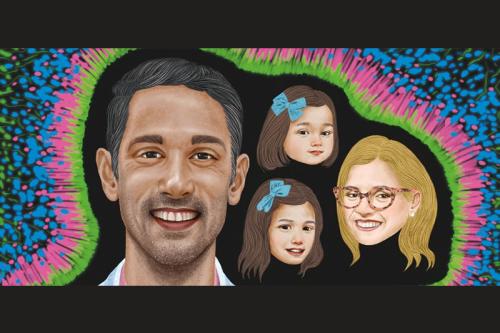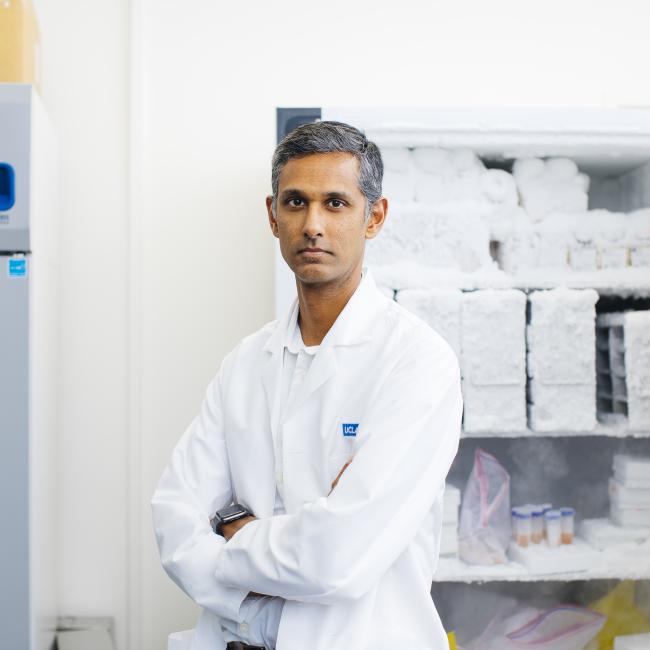
From U Magazine: Q&A with Dr. Ranmal Samarasinghe: Insights in a petri dish
As a clinical neurophysiologist, Dr. Ranmal A. Samarasinghe manages patients with epilepsy, and his research focuses on understanding its underlying causes and those of related disorders like autism. To do so, his lab grows and studies 3D structures called human-brain organoids. Generated from the stem cells of individual patients, these organoids can mimic some of the neural-circuit abnormalities seen in the brains of patients with epilepsy and can provide unique insights into the causes of human neurological diseases. Dr. Samarasinghe hopes that his work will reveal why some patients do not respond to current therapies and inform the development of new treatments and cures.
WHEN DID YOU FIRST START TO THINK ABOUT SCIENCE?
I think I was about 5 or 6 years old. My dad had this Charlie Brown book called “The First Book of Science,” or something like that, and he was teaching me about chlorophyll and photosynthesis. He was telling me, “This is science. If you’re interested, maybe this is something you can do.” I remember thinking, “Oh, OK, maybe I can do that.” There was another chapter that talked about how you could tell how old a tree is by counting its rings, and I thought that was the most amazing thing. After that, if I saw a tree that had been cut, I would try to count the rings. I still do that sometimes.
WHAT WAS YOUR FIRST EXPERIMENT?
My first real experiment probably was in the fourth grade. My teacher — I still remember him, Tom Ferry — was really into isopods, those little bugs that roll up into a ball if you touch them, and we did an experiment to see how they would behave in response to heat or cold. We made a foil bridge and put the isopods on it, with a heat lamp at one end and a shaded area cooled with ice at the other. Our hypothesis was that they would prefer the cool, shaded area, and that’s just what they did.
WHAT HAS BEEN THE GREATEST CHALLENGE IN YOUR WORK?
Just having the confidence to do it can be a big challenge. I’m surrounded by people who are super-accomplished and so smart, so, sometimes it feels like a challenge to just put my head down and do the work.
WHERE DOES YOUR INSPIRATION COME FROM?
It is jarring and sad to see children in the epileptic encephalopathy clinic who have such difficult medical issues and the devastating impact that has on their lives and on their families. I am a parent now, and perhaps that makes me even more motivated. Wanting to do something to help them is where the inspiration comes from.
WHO IS YOUR SCIENCE HERO?
I don’t know that I have a hero, per se, but there are people who have made a big difference in my life. Mr. Ferry, my fourth-grade teacher, was one of them. I wasn’t very good in school, but he took an interest in me and he was supportive and guided me toward believing that I wasn’t as bad as I thought I was. The first scientist who really inspired me to pursue research was Dr. Keiko Ozato at the National Institutes of Health. I worked in her lab as a post-baccalaureate trainee, and she was my first real scientific mentor.
WHERE ARE YOU HAPPIEST?
With my wife and kids at home or wherever we are together. We have two girls, 5-1/2 and 2-1/2 — and a third child on the way — and I am happiest being with them and doing whatever it is they want to do.
WHAT DO YOU CONSIDER TO BE YOUR FINEST ACHIEVEMENT?
I’m still working on it.
WHAT ARE THE QUALITIES OF A GREAT SCIENTIST?
Healthy skepticism and persistence. There is a lot of failure when you do science. So much of it doesn’t work out the way you expect, and so you have to be persistent in your pursuit. And you also have to be skeptical even of your own results and not take them at face value. Your hypothesis may seem to be correct, but it could prove to be wrong in the future based on new evidence.
WHAT IS YOUR GREATEST VIRTUE?
I’d say I’m pretty persistent.
WHAT IS YOUR GREATEST FAULT?
I can be impatient. Sometimes I need to take a step back and slow down.
WHAT IS YOUR MOTTO?
There’s always tomorrow.
WHAT DO YOU VALUE MOST IN YOUR COLLEAGUES AND STUDENTS?
Their honesty. From my students, an honest effort in the lab, and from my colleagues, honest feedback and collaboration.
WHOM DO YOU MOST ADMIRE?
My wife. She is an MD/PhD in the Department of Emergency Medicine and Orthopaedics. Despite her own busy schedule, by sharing and helping with both household/childcare and other tasks, being a sounding board for managing lab-related issues both scientific and otherwise, reading manuscripts and grant proposals, she plays a very significant role in making it possible for me to pursue my work and succeed as a scientist. I probably should tell her more often how much I appreciate and admire her.
WHEN DO YOU NOT THINK ABOUT SCIENCE?
I may think about science when I’m running or biking and I have a clear head to think about a problem, and, of course, when I am focused on my work in the lab. But there are lots of other times during the day when I’m not thinking about it at all — I’m thinking about my wife or my kids or what is going on in the world.
IF NOT A SCIENTIST, WHAT WOULD YOU BE?
If I had the ability, I would want to be a professional cyclist. But since I don’t have that level of talent and it is not something that’s ever going to happen, I think I would have been a political scientist or political economist. In addition to biology, my first degree was in economics. I still think about that stuff and read about it for fun.
TO WHICH SUPERHERO DO YOU MOST RELATE?
I can tell you who I admire. I admire someone like Rey from Star Wars, or even the Wolverine. They are characters who could’ve very easily been villains; terrible things were done to them or happened to them when they were growing up. But they didn’t become villains. They became heroes, but there’s still a dark side to them that they had to overcome and, in the case of Rey, kind of become the epitome of good.
WHAT ARE YOU MOST COMPULSIVE ABOUT?
Probably getting in my run. I run only three-to-six miles, but I do it six days a week, and I bike on the day I don’t run. I haven’t skipped a day in over a year-and-a-half.
HOW DO YOU WANT TO CHANGE THE WORLD?
I want to raise children who grow up to be productive and good citizens who contribute to making the world better. And I want them to be happy. I don’t yet know if what I do in the lab or in clinic will make a significant impact, but I am optimistic that if my kids grow up to be good citizens and are happy, the world will be better off for it.
WHAT IS YOUR DEFINITION OF HAPPINESS?
Spending time with my family.
WHAT IS YOUR DEFINITION OF MISERY?
Being alone.
WHAT MUSIC DO YOU LISTEN TO WHILE YOU WORK?
I’m a bassist, and I like to listen to musicians like Jaco Pastorius, MMW [Medeski, Martin and Wood] and Galactic — sort of funk, jazz, beat stuff. And I’ll also listen to Led Zeppelin, Jimi Hendrix and music like that. That’s what I listened to in high school; there were four of us nerds who just wanted to listen to that music and play that music all the time. With music like MMW, I can have it on in the background and work, and I feel I can be productive. With some other music, I have to just stop what I am doing and listen and kind of get lost in it.
